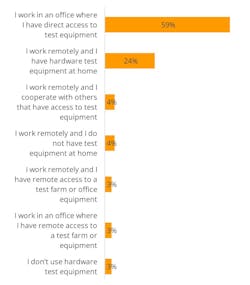Where Do You Engineer?
What you’ll learn:
- The results of our hardware test & measurement survey.
- Conclusions drawn from the survey.
When it comes to engineering, there are lots of ways to work remotely when your primary tool is a computer. However, not all design engineering tasks can be performed in that way. This is especially the case in the test & measurement arena, which can require a number of specialized (and expensive) devices. Such work can only be performed if the engineer in question either has those tools, or their organization has advanced devices that allow for remote access and operation.
We recently surveyed our engineering readership to tell us about how they use hardware test & measurement tools, and if they do so remotely or on-site. We asked if they worked in an office with direct access, if they worked with hardware at home, had remote access to equipment, or had on-site colleagues who used the equipment and worked with them. The answers we received were interesting and informative (see figure).
More than half of the respondents still work in an office where they have direct access to test equipment (59%), while 24% said they work remotely with hardware test equipment at home. This shows the importance of hands-on access to the tools needed to do the job. The surprise answer was the low number of engineers who aren’t using networked equipment remotely to perform their tasks.
Such connected tools have been around for a while now, and with the pressure to work remotely, it’s interesting that this solution hasn’t been further explored. The issue of adoption could relate to the need to have someone at the remote device performing the hands-on aspects of probe placement and manipulating the device under test. These connected tools can be a powerful force multiplier in remote work, but procedures and methodologies must be developed to use them properly.
The big takeaway from this survey is the high percentage of engineers that have the test & measurement hardware at home. This makes sense, as the hands-on aspect of testing hardware makes it a challenge to use such gear remotely. By having the test equipment at home, an engineer can work comfortably and effectively at home.
However, such an approach is also the most expensive for the organization involved, and it can create inventory-management issues and upgrade challenges. Remote tools are able to address this issue, but methods and means must still be worked out for those who could benefit from that approach.
You can also check out other Electronic Design Quick Polls.
About the Author
Alix Paultre
Editor-at-Large, Electronic Design
An Army veteran, Alix Paultre was a signals intelligence soldier on the East/West German border in the early ‘80s, and eventually wound up helping launch and run a publication on consumer electronics for the US military stationed in Europe. Alix first began in this industry in 1998 at Electronic Products magazine, and since then has worked for a variety of publications in the embedded electronic engineering space. Alix currently lives in Wiesbaden, Germany.
Also check out his YouTube watch-collecting channel, Talking Timepieces.


